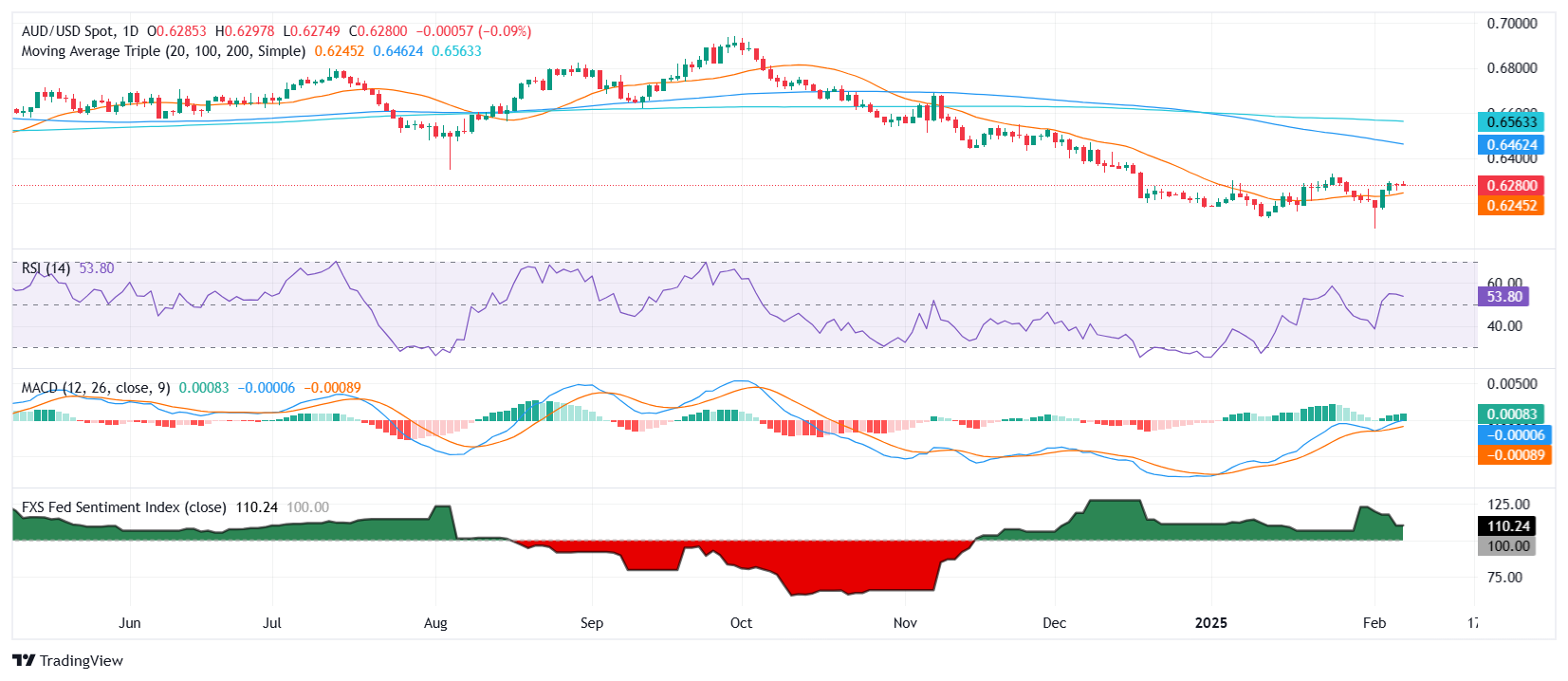- Analytics
- News and Tools
- Quotes
- Chart and quotes for AUDUSD
CFD Trading Rate Australian Dollar vs US Dollar (AUDUSD)
| Date | Rate | Change |
|---|
Related news
-
18.02.2025 09:07AUD/USD: Expected to trade in a 0.6335/0.6370 range – UOB Group
Australian Dollar (AUD) is expected to trade in a 0.6335/0.6370 range vs the US Dollar (USD). In the longer run, momentum remains strong; AUD could continue to advance, potentially to 0.6410, UOB Group’s FX analysts Quek Ser Leang and Peter Chia note.
AUD can continue to advance
24-HOUR VIEW: "Following AUD sharp rise last Friday, we pointed out yesterday that 'the rally appears to be overdone, and AUD is unlikely to rise much further.' We expected AUD to 'trade in a 0.6325/0.6375 range.' AUD subsequently traded in a narrower range than expected (0.6346/0.6374), closing largely unchanged at 0.6357 (+0.06%). We continue to expect range trading today, but the softened underlying tone suggests a lower range of 0.6335/0.6370."
1-3 WEEKS VIEW: "Our update from yesterday (17 Feb, spot at 0.6355) remains valid. As highlighted, 'momentum remains strong, and we continue to expect AUD to advance, potentially to 0.6410.' On the downside, should AUD break below 0.6290 (no change in ‘strong support’ level from yesterday), it would mean that 0.6410 is out of reach for now."
-
17.02.2025 10:53AUD/USD: Unlikely to rise much further – UOB Group
-
17.02.2025 10:15AUD/USD refreshes two-month high near 0.6370 ahead of RBA monetary policy
-
16.02.2025 23:01AUD/USD holds below 0.6350 ahead of RBA rate decision
-
14.02.2025 12:00AUD/USD: Graphical levels at 0.6330/0.6360 represent crucial resistance – Societe Generale
-
14.02.2025 10:53AUD/USD: Likely to rise to 0.6355 – UOB Group
-
13.02.2025 10:42AUD/USD has a chance to test its YTD high of 0.6330 – BBH
-
13.02.2025 09:25AUD/USD: Buildup in momentum is fading – UOB Group
-
12.02.2025 14:07AUD/USD flirts with weekly lows near 0.6230 post US CPI
-
12.02.2025 10:22AUD/USD declines from two-week high around 0.6300, US CPI in focus
-
12.02.2025 08:42AUD/USD: To rise above 0.6310 – UOB Group
-
11.02.2025 09:59AUD/USD consolidates near the top-end of the 0.6100-0.6330 range – BBH
-
11.02.2025 08:58AUD/USD Price Forecast: Remains confined in a familiar range below 0.6300 mark
-
11.02.2025 08:45AUD/USD: Buildup in momentum is fading – UOB Group
-
10.02.2025 10:37AUD/USD bounces back to near 0.6280 as investors shrug off US Trump’s tariff threats
-
10.02.2025 10:30AUD/USD: Not expected to breach 0.6200 – UOB Group
-
09.02.2025 23:12AUD/USD faces some selling pressure to near 0.6250 amid trade war threat
-
07.02.2025 13:09AUD/USD steady as markets brace for US jobs data
-
07.02.2025 11:22AUD/USD continues to face pressure near 0.6300, US NFP in focus
-
07.02.2025 10:43AUD/USD: Sustained break above 0.6310 is unlikely – UOB Group
© 2000-2025. All rights reserved.
This site is managed by Teletrade D.J. LLC 2351 LLC 2022 (Euro House, Richmond Hill Road, Kingstown, VC0100, St. Vincent and the Grenadines).
The information on this website is for informational purposes only and does not constitute any investment advice.
The company does not serve or provide services to customers who are residents of the US, Canada, Iran, The Democratic People's Republic of Korea, Yemen and FATF blacklisted countries.
Making transactions on financial markets with marginal financial instruments opens up wide possibilities and allows investors who are willing to take risks to earn high profits, carrying a potentially high risk of losses at the same time. Therefore you should responsibly approach the issue of choosing the appropriate investment strategy, taking the available resources into account, before starting trading.
Use of the information: full or partial use of materials from this website must always be referenced to TeleTrade as the source of information. Use of the materials on the Internet must be accompanied by a hyperlink to teletrade.org. Automatic import of materials and information from this website is prohibited.
Please contact our PR department if you have any questions or need assistance at pr@teletrade.global.

















